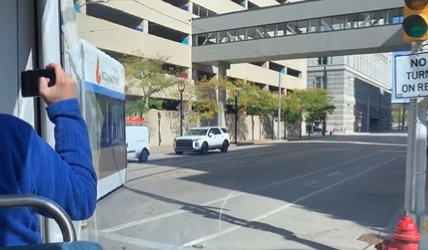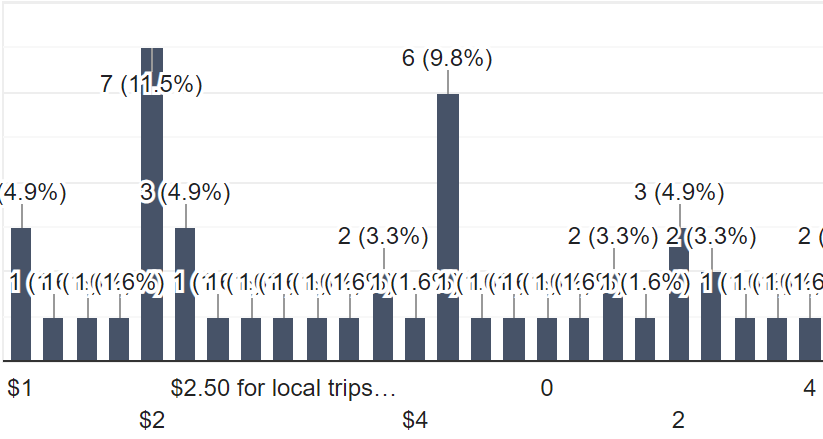MILWAUKEE — On a pleasant Wednesday afternoon in early October, a group of Milwaukee media members stood with their hands on stability straps as a historic right turn was executed by a Milwaukee streetcar driver from Milwaukee Street to Michigan Street:

With that right turn, The Hop had ventured outside of its primary M-Line layout for the first time since its 2018 launch, down the oft-delayed, but much anticipated, ‘L-Line’ extension. It rode towards what will eventually serve as a city transit hub for The HOP, the Milwaukee County Transit System’s CONNECT-1 bus rapid transit, and other downtown MCTS bus lines.
It’s the first extension of Milwaukee’s streetcar network, and in many ways represents the constant back-and-forth over the system for the last nearly 10 years. Much of the conversation surrounding the city’s foray into modern urban streetcar transportation dating back to its proposal early last decade has focused on whether or not the service is sustainable long-term.
Speaking at the unveiling of the city’s ‘Downtown 2040’ plan earlier this year, Mayor Cavalier Johnson proclaimed that “Milwaukee is at a critical crossroads”. And so, it would seem, is its streetcar.
From the launch in 2018 up until the COVID-19 pandemic, ridership on the free-to-ride system was high, reaching a peak of over 3,300 riders per day in July of 2019. Since March of 2020, despite an uptick in the past 12 months and consistent year-to-year growth since the pandemic, those numbers have not fully recovered. Additionally, the pandemic seemingly put the brakes on any public talks of expanding the system past the L-Line, though conversations have continued behind closed doors.
“Would you be willing to pay?”
Also on hold, at least for now, are any plans to institute a fare for the streetcar. It was part of the HOP’s original plan to implement a fare after one year of service. But four years since that original timeframe was laid out, Department of Public Works Commissioner Jerrel Kruschke told me that as long as the system is breaking even, the costs of operation, and a desire to keep ridership trends in the right direction, outweigh fare revenue.
“Fares have always been a conversation with the streetcar since day one,” Kruschke said after the October 11th ride-along on the new L-Line. “It’s not free to run a fare system. So if we wanted to start charging, it’s always on the table, but it really ties down ridership where we’re going, and how much does it cost the city? So to run a fare system while we’re breaking even doesn’t make sense.”
Despite fears that ridership would plummet if a fare were instituted, that doesn’t appear to be the case from our research. In a survey WTMJ conducted with listeners, one of our questions asked was: “Would you be willing to pay a fare to ride The HOP if it meant an extension would happen to your preferred destination?”

As you can see from our responses, 77 percent of those surveyed said they would in fact pay a fare if destinations such as Fiserv Forum, American Family Field, UW-Milwaukee, and even Mitchell International Airport, were a part of the system. As the system eventually pursues expansions that were part of the streetcar’s original plan, it appears that passengers will continue to ride, even if a fare is implemented.
As for how much a trip on The Hop should cost, the average fare our surveyed riders would be willing to pay for a fleshed-out HOP was $2.12 per ride.
Using the latest numbers available from the HOP’s website, based on the expected average number of riders monthly for 2023, even just a one-dollar fare would accumulate approximately $514,400 in gross revenue. That would be the Hop’s fourth-largest source of revenue yearly, ahead of various non-naming rights sponsorships and the current federal transit support grant of $214,000.
At $2.12, that number jumps to $1,090,528. Even adjusting for a 23 percent ridership loss related to our above survey findings, that $2.12 charge could theoretically still raise just under $840,000 in gross fare revenue (this assumes the average rider uses the system twice a day).

Of course, as Kruschke notes, taking into account the costs of operating a fare system is important. A 2022 report by the National Transit Database found that the $20,381,505 in Milwaukee County Transit System revenue represented 14.4% of the system’s 2021 operating costs.
The 2022 city budget called for $4.6 million to be spent on operating the streetcar system, so a similar ratio would require $622,400 to be generated by fares — a bit higher than the 514,000 calculated by current ridership averaged at a one-dollar fare, but bear in mind, the trend the last two years has seen ridership slowly return to near pre-pandemic levels.

As for operational costs specific to a hypothetical Hop fare collection system, DPW Marketing and Communications Officer Tiffany Shepherd told me the department will be looking to do a cost analysis once the L-Line is fully operational.
Shepherd did note their initial assessments indicate a fare could lead to inequity issues aboard the system for those in lower economic strata. “The Federal Transit Administration would require MSS to conduct a fare equity analysis as part of its implementation,” Shepherd said. “According to a SEWPC survey conducted in 2019, the percentage of Hop riders making less than 74k was 66.2% of the ridership. This indicates that the HOP is a very equitable way to get around downtown and is helping the population most affected by equity improve accessibility to the downtown area.”
But Alderman Scott Spiker noted at a Finance & Personnel Committee budget hearing on October 5th that in the streetcar’s current iteration, the lines pass through areas where residents generally earn higher salaries, and with that base being the primary streetcar users that they could likely afford paying a low fare. Also at that meeting, Alderman Mark Murphy indicated there will be a 1.3 million dollar operational shortfall for the streetcar in 2024.
“A symbiotic relationship”
Kruschke notes that in other metros of similar size to Milwaukee that have streetcar networks, previous fares were reduced or eliminated. “We’ve seen other sister cities that have streetcar operations which have fares have removed them”.
One of those sister cities is Cincinnati, where the “Bell Connector” streetcar operated with a one-dollar fare from its inception in 2016 until a resolution in October 2020 by the city council made the streetcar fare-free. According to the Cincinnati Enquirer, the streetcar has a $5 million annual operating budget, funded through grants, advertisements, naming rights and a tax incentive for local property owners.
In 2020, WCPO-TV in Cincinnati noted that “in a May 2019 memo, then-City Manager Patrick Duhaney estimated that the Connector had brought in roughly $330,000 in fares in 2018, but the cost to collect those fares — including printing the tickets, maintaining the ticket vending machines and paying fare inspectors — offset that revenue by nearly $260,000.”
Another city with a similar streetcar setup to Milwaukee’s is Kansas City. Interestingly, with the inclusion of the L-Line, the Hop is actually 0.6 miles longer than the KC Streetcar’s downtown loop connection to the city’s Union Station in the south, passing through the popular Power & Light District, and circling the City Market.
Kansas City’s streetcar also operates fare-free, though KC Streetcar Authority executive director Tom Gerend says the city is still earning a cut of revenue by means of tax districts which generate a revenue stream.
“We have a taxing jurisdiction where we collect a fare indirectly off the economic activity,” said Gerend. “People ride our system, they shop at businesses, they go to restaurants, they stay in hotels. The more people we move, the greater the economic impact. And we get to capture some of that through an indirect fare on those economic transactions in a way that creates this sort of symbiotic relationship.”
This type of tax district would not work to fund expansion or operation of The HOP, since the shared revenue bill approved this summer prohibits revenue from property tax levies or sales taxes to be used for development, operations, or maintenance of a streetcar system.
As the city continues finding ways to generate revenue for, and ultimately expand the streetcar, it’s important not to leave any dollars on the table. Especially considering the unique ways funding is regulated by the state.
And at least according to the numbers, the current rider base by and large plans to stick around, even if they have to pony up to hop on.
Hear Adam’s full report as part of “Milwaukee’s Streetcar: A Critical Crossroads”:
The Milwaukee Business Journal’s Sean Ryan discusses how the City of Milwaukee is exploring new ways to pay for streetcar expansion.
TMJ4 News’ Adriana Mendez reports on the construction process of the “L-Line”, and what current riders want to see from the system in the future.



























